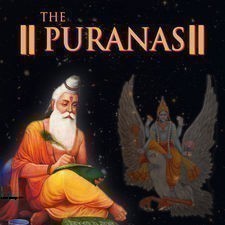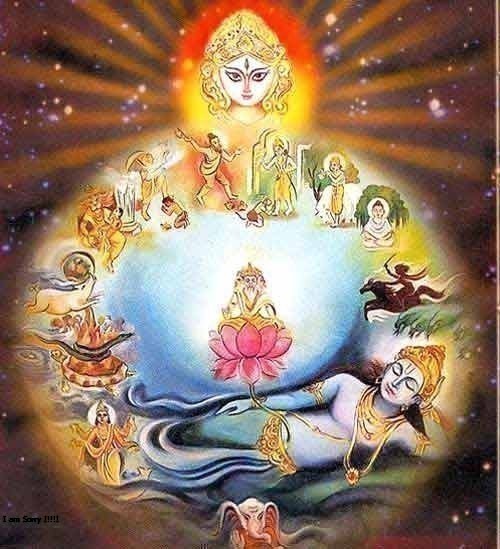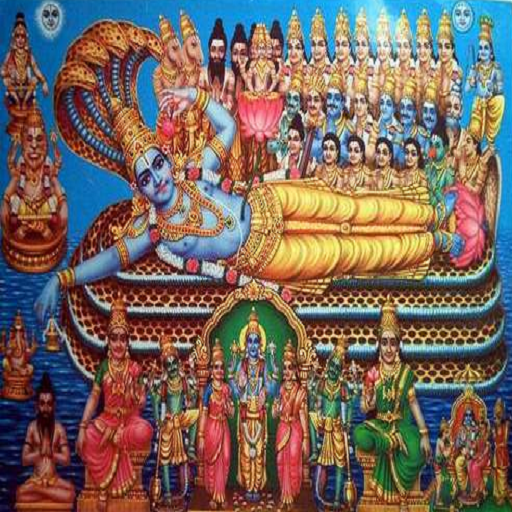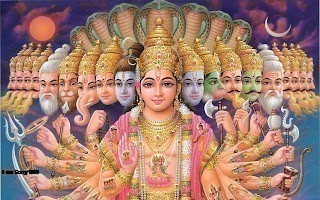About Puranas
The Puranas are ancient and very important religious texts belonging to the Hindu, Jain and Buddhist pantheons. These consist largely of narratives about the history of the universe and its numerous epochs or cycles from creation to destruction, genealogies of kings, heroes, sages, and demigods. These texts also deal with Hindu cosmology and philosophy.

the Puranas deal with the complete description of a particular deity and are usually written story form, related by one person to another. These stories and tales relate the omnipresent, omnipotent and omniscient nature of God and that all Hindus should completely surrender their all to Him. The Puranas are also available in several of India's vernacular tongues and are spread among the common folk by Brahmin scholars, who read from them and tell them stories, usually during their Katha sessions. The Brahmin scholar usually travels from village to village, lives in the temple premises for a period of time and conducts these Katha sessions during this time.

Rishi Vyasa, the narrator of the Mahabharata, is believed to have originally compiled the Puranas. But the earliest written record of this text dates back to the time of the Gupta Empire, around the 3rd-5th Centure CE. Of course, this date does not in any way indicate the date of origin of the Puranas. But experts believe the Puranas are essentially dynamic in nature and have constantly evolved and been modified over the subsequent centuries and continue so even to date.There are 18 main Puranas, also referred to as the Mahapuranas. There is also an equal number of subsidiary or Upa-Puranas.Vyasa was left dissatisfied even after having written the Mahabharata. Sage Narada went to him and asked him, then, to write Srimad Bhagavatam, or the Bhagavata Purana. This is considered the most important Purana, as it describes the ten incarnations (Dashavatara) of Lord Vishnu and also gives a detailed account of Lord Krishna's life. The Bhagavata Purana is divided into twelve cantos or chapters and has a total of 18,000 verses.
Vyasa then imparted the knowledge of Bhagvatam to his son Suka Bramha Rishi. Suka then recited the same to Maharaja Parikshit, a great and wise King, in an assembly of learned saints. He had unfortunately received a curse that he would die within the following week. He then renounced his kingdom and stayed at the bank of the Ganges, in order to fast unto death.
The Bhagavatam starts with Parikshit asking Suka Brahma rishi to give him the knowledge of the right path and liberation. The sage, in response, narrated the Bhagavatam to him for the seven days, till the king breathes his last. According to Skanda Purana, "Whoever makes a copy of the Bhagavatam and donates it, on a golden lion throne, on the full moon day in the month of Bhadra, will attain the supreme destination".
The second section deals with tales of Prithu's descendants, the Prachetas, the tale of Prahlada and Hiranyakashipu (where Vishnu takes the form of the half-man half-lion Narasimha), some concepts of the universe, and tales of the many births of Jadabharata.

The Vishnu Purana, again a very important one in the Mahapurana list, is considered a Puranaratna or gem among Puranas. Presented as a dialogue between Parashar and his disciple Maitreya, this Purana is split into six amsas or parts and 126 adyayas or chapters. The creation of myths, stories of battles fought between the Devas and the Asuras, the Dashavataras of Vishnu and genealogy of legendary kings form the basic topics of this Purana. According to the Matsya Puranas, the Vishnu Purana has 23,000 slokas or verses. But in actuality, experts have found only about 7,000 verses.This text introduces the concept of four yugas or epochs. The story of Rudra, the Samudra Manthan or the Churning of the Milky Ocean, the tale of Dhruva, an ardent devotee of Vishnu, and tales of kings Vena and Prithu feature in the first section.
The third amsa of the Vishnu Purana talks about sages Vyasa and Yajnavalkya, Surya (the Sun God), Yama (the God of Death) and the major devotees, Shatadhanu and Shaivya. This section also gives details about the four varnas or classes, four ashramas or stages of life and details of many rituals. Most importantly, this section also deals with the Manvantara or the cycles of creation and destruction, of birth and death.
The fourth amsa gives an account of all the famous Kings from the solar and lunar dynasties of ancient India, as also the list of the names of kings who would rule in the present age of the Kali Yuga. In the Kali Yuga section, the text clearly elucidates the concepts of universal destruction that would eventually follow as a result of extreme violence, injustice and corruption. It states that this Yuga would witness that the only means to success would be falsehood and that corruption would become the rule of the day. It also explains the importance of the Puranas in the Hindu pantheon. The Vishnudharmottara Purana appears as an Appendix to the Vishnu Purana and is dedicated completely to the arts.
Also known as Smriti, the Garuda Purana is a Vaishnava Purana. The first part is a dialogue between Vishnu and his vahana (vehicle) Garuda, while the second talks about life after death, funeral rites and the principles of reincarnation. This Purana deals with astronomy, medicine and gemstone qualities. The Garuda Purana has nineteen thousand slokas. Vyasa had taught the Puranas to his disciple, Romaharshana. It was this disciple who related the stories to one and all. It is believed that Suta, the son of Romaharshana, related the same to sages. But some others believe that Romaharshana, himself belonging to the Suta class, could have related the Puranas to the sages, and not his son.

Also known as Smriti, the Garuda Purana is a Vaishnava Purana. The first part is a dialogue between Vishnu and his vahana (vehicle) Garuda, while the second talks about life after death, funeral rites and the principles of reincarnation. This Purana deals with astronomy, medicine and gemstone qualities. The Garuda Purana has nineteen thousand slokas. Vyasa had taught the Puranas to his disciple, Romaharshana. It was this disciple who related the stories to one and all. It is believed that Suta, the son of Romaharshana, related the same to sages. But some others believe that Romaharshana, himself belonging to the Suta class, could have related the Puranas to the sages, and not his son.